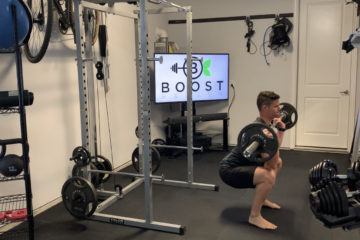
Symptoms Of Low Testosterone
I have had the topic of testosterone on my list of podcast topics for a long time. When a friend of mine reached out recently for some advice about reduced testosterone, I decided this would be a good time to bring it up on the show and dig into the research.
According to a 2006 study in JAMA, the symptoms of low testosterone include:
Decreased muscle mass
- Decreased bone mineral density
- Increased fat mass (especially in the abdomen)
- Insulin resistance
- Decreased libido
- Low energy
- Irritability
- Dysphoria
For my friend it has been a complex cocktail of intense endurance training, low body mass, and too little calorie intake that has likely brought about this unfortunate low level of testosterone. This dangerous combo is not uncommon in endurance athletes as we will discuss later. That said, anyone who is exercising so intensely that they are overtraining, could be at risk for hormonal imbalance like this. On top the symptoms mentioned above, my buddy also mentioned he had:
- Poor workout recovery
- Digestive issues
- Poor sleep
He is a young man so this is obviously a bit scary for him to be going through. He is working with a doctor on getting his testosterone back to a safe level and he has agreed to join us on a future episode to share his experience and what strategies were helpful. In the meantime I have put together 11 tactics to improve testosterone levels naturally:
1. Not Just For The Fellas
For you ladies that think testosterone is only important for men, think again. A 2015 study in The Lancet Diabetes and Endocrinology mentions that testosterone is an essential hormone for women (not just men) and is critical for many functions including cardiovascular, cognitive, and musculoskeletal health.
In a 2011 study in Sports Medicine, strength training and acute endurance training increase testosterone in men and women. The authors mention that having enough testosterone is critical for men and women in the health of the reproductive system, muscle growth and the prevention of bone loss. They also mention that chronic training or overtraining can cause a decrease in testosterone.
A 1998 study in the European Journal of Applied Physiology and Occupational Physiology found that concentrations of total testosterone were increased in men and women with resistance training 2-3 times per week. The testosterone levels were noted to be significantly higher after 6 and 8 weeks of training over the 8 week study period.
2. Full Body Strength Training
As discussed previously, strength training is a great way to increase your testosterone levels. The actual strength training program itself can make a difference in how much testosterone is increased. As I mentioned in my article on Full Body Strength Training versus Split Group Strength Training, a 2016 study in Biology of Sport found that a full body workout will actually increase testosterone more than a split group workout. This makes sense intuitively if you think about it. What is going to ramp up your hormones more? Will sitting on a bench doing bicep curls or performing a squat with overhead press create a bigger hormone response? I think the answer is clear. Also your biggest muscles in your body are in your legs and glutes. Think of the difference in hormone response if we train these 3 times per week as part of a full body workout versus only 1 time as part of a split routine.
3. No Extremes Or Overspecialized Training
This coming from the guy that recommends daily exercise? Yes. But there is a big difference between getting an hour of activity on a daily basis in a carefully designed program that blends strength training with cardio training versus training for multiple hours daily in just one discipline. Crossfit champion Mat Fraser said during competition, “None of those things are in my wheelhouse, but I train every day to not have a wheelhouse”. While I am not a fan of all the elements of Crossfit, I do like the general concept of not overspecializing. There has been some research showing that overtraining can cause reduction in testosterone. A 2009 study in the Journal of Endocrinology looked at how running 5 times per week would affect testosterone levels. The researchers split the runners into 2 groups where one group did moderate intensity (60% of VO2 max) and the other group did high intensity (80% of V02 max). Both groups ran 5 times per week for 60 weeks. The sessions were on a treadmill and each session lasted 2 hours. While this might sound outlandish to some folks, it is not unheard of to train 10 hours per week for endurance athletes. After only 12 weeks of sessions, testosterone levels in both groups (moderate and high intensity) began to fall.
Not to just pick on endurance athletes, it seems that similar results might be found for strength training enthusiasts. A 2013 study in the International Journal of Sport Physiology and Performance found that a natural body builder going through extremes of diet and exercise can lost about 7 ng/mL (nanograms per milliliter) of testosterone. His testosterone level went from a healthy level at 9.2 ng/mL to a very unhealthy low level of 2.2 ng/mL while preparing for competition. Why not just have nice body composition all the time instead of these big, unhealthy swings?
The key is a balanced training program. I like to recommend 3 days of full body strength training on nonconsecutive days like Mondays, Wednesdays, and Fridays, and cardio training on Tuesdays, Thursdays, Saturdays, and Sundays. The goal would be about 60 minutes for each session to keep overtraining at bay in any given discipline.
4. Don’t Cut Carbs
A 1987 study in Life Sciences found that testosterone levels plummeted for participants on a high protein/low carbohydrate diet versus those on a high carbohydrate/low protein diet. I am not suggesting we should go low protein based on this. But I am recommending we keep things balanced. It is silly to cut out an entire macronutrient. Don’t be afraid to eat high quality, nutrient dense, carbohydrates found in vegetables, fruits, grains, etc. Apparently lowering carbs too much can have deleterious affects to your testosterone.
5. Eat Blackstrap Molasses
I discussed this superfood in my article and show on nutrient analysis of a plant-based diet. I added it to my diet after learning that it provides a megadose of calcium and iron. But there is even more that this wonderful food can help with apparently. A 2010 study in the African Journal of Food Science found that blackstrap molasses increased testosterone levels! Now I have one extra reason to make sure I take my 2 tablespoons of this daily. It isn’t the tastiest treat in the world but I have a few walnuts with it that helps balance out it’s potent flavor. Now this could be purely coincidental, but I have noticed a little bump up in my heart rate variability score each day since I started taking blackstrap molasses. I talk about how and why I take my heart rate variability (HRV) daily to track how recovered my body is from a nervous system standpoint in my article on the topic. I can’t think of any other variables that have changed in that time so the blackstrap molasses might just be a difference maker for me in recovery with the improved levels of calcium, iron, and testosterone!
6. Do High Intensity Interval Training (HIIT)
A 2012 study in Hormones found that HIIT increased free testosterone more than steady state cardio. The participants were 15 highly trained males in their late 20’s. They performed a HIIT session with 90 second sprints paired with 90 second recovery jogs over 42-47 minutes. They also performed a 45 minute endurance run at 60% of their VO2 max. For a control they just lied in a supine position at rest for 45 minutes. Blood samples were taken before each session, directly after the session, and then 12 hours after the session. The study showed a significant increase in the testosterone levels in the 12 hour measurement for the HIIT workout versus no increase in testosterone in the 12 hour measurement for the endurance workout or control.
A 2011 study in the Journal of Strength and Conditioning Research found that adding running sprints significantly increased total testosterone and VO2max in competitive wrestlers. The running sprints were performed as 6 sets of 35 meter sprints with 10 second rest intervals. This was done 2 times per week for 4 weeks.
A 2017 study in Endocrine Connections found that HIIT increased free testosterone levels. The participants were men over 60 years old. They used a cycling ergometer and did 6 sets of 30 second sprints paired with 3 minutes of active recovery. This occurred in 9 sessions over course of 6 weeks. It also increase their peak power production.
Now there is good reason for me to continue doing my short 30-60 sec sprints that I do when cycling with my buddies!
7. Get Some Vitamin D
A 2011 study in Hormone and Metabolic Research found that supplementing with 3000 IU of D3 significantly increases testosterone. Another wonderful way to get vitamin D is through sunshine. The amount of time outside and time of day will vary depending on where you are in the world, but a good general rule of thumb is to get outside in midday sun, without sunscreen, for about 20 minutes, several times per week. A 2010 study in the Journal of Investigative Dermatology found that participants in the UK got adequate levels of vitamin D from 13 minutes of midday sun exposure to 35% of skin surfaces (they were wearing shorts and t-shirts). My multivitamin has 2500 IU of D3 in it and I also take a work break during the middle of the day to get outside and soak in some rays for 15 or 20 minutes. The combination of getting sunshine when possible and having the multivitamin fill in any gray days seems to be a good strategy.
8. Sauna
Those of you that heard or watched episode 51 which covered the benefits of sauna, might recall that increased growth hormone was one that was discussed. It appears that a mild increase of testosterone may also occur with sauna use. According to a 1989 study in the European Journal of Applied Physiology and Occupational Physiology, increased sauna use caused an increase in growth hormone and testosterone and a decrease in cortisol. And speaking of cortisol…
9. Control Stress
Most folks are aware that when you are stressed, your levels of a hormone called cortisol increase. High cortisol levels can lead to increased fat storage and a slowing metabolic rate which are certainly undesirable. On top of that, when cortisol levels rise, a decrease in testosterone typically occurs. A 2010 study in Hormones and Behavior showed that a type of hormonal balancing act occurs where when cortisol levels rise in stressful situations, testosterone levels decrease. Considering this, and the other long term health benefits to managing your stress levels, it would be wise keep stress under control as much as possible.
10. Sleep
Oh how boring right? Just another thing that sleep helps with. Well add more testosterone to your list of reasons to get more sleep. I promise you won’t be mad at yourself in the morning. I was always a 6-7 hour per night person and I usually felt ok with this. But then I saw a 2017 article on the Popular Science website, where the director of the sleep and neuroimaging lab at the University of California, Berkeley, Matthew Walker, says that we actually need a minimum of 8 hours to mitigate reduction of cognitive performance. It is one thing to feel “ok” after 6 or 7 hours, but if we are not performing at our best then that is a bad sign. Now I just go to bed at the same time as our kids at 8:30 and then sleep until 4:30 or 5:00am and get a solid 8 hours. How much sleep do we need from a testosterone perspective? There doesn’t appear to be any research that I could find showing a specific number of hours for optimal testosterone levels, but there are lots of studies showing that not enough sleep can cause testosterone levels to drop. For example a 2011 study in JAMA looked at what would happen if sleep was restricted in young healthy men in their 20’s. They were restricted to 5 hours per night for 1 week. The testosterone levels of all of the men dropped 10-15%! Obviously other factors will affect testosterone like sleep quality and lifestyle outside of sleep hours, but we know 5 hours is not enough if healthy young males lose testosterone with this amount of sleep. According to this same study about 15% of working adults in the US get less than 5 hours. So you may wonder if 6 or 7 hours is enough. As I mentioned, I haven’t seen studies to show the minimum requirement, and this may be likely due to the vast number of variables. But we do know that 8 hours is best for cognitive function based on the aforementioned study at Berkley. So why not just shoot for 8 hours of sleep and know you are getting enough for brain power and testosterone?
11. Monitor Your Heart Rate Variability
If you have been following the show for a while, you know I am big believer in keeping an eye on your Heart Rate Variability (HRV) score daily to see how recovered you are. A 2010 study in a Turkish cardiology journal found that there is a positive correlation between testosterone and HRV score. This makes sense after we learned that stress can decrease testosterone. HRV tells us a story of how recovered our body is from stress from a nervous system standpoint. Based on this research we can also make a general assumption now that our testosterone is higher when our HRV score is higher. This is really exciting to me since I have had a higher HRV score lately, as I mentioned earlier, in what I think is due to getting some extra minerals from blackstrap molasses. This really brings things full circle and shows how connected our body systems are.
Please click the link below to your favourite podcast app to listen in or watch the show on BOOST Health TV
Podcast: Play in new window | Download
Subscribe Apple Podcasts | Google Podcasts | RSS







